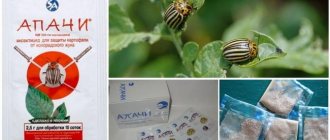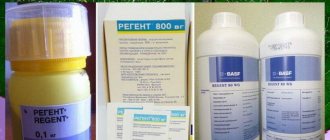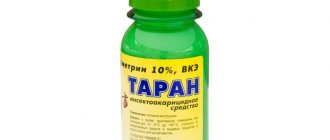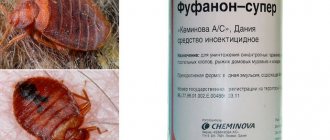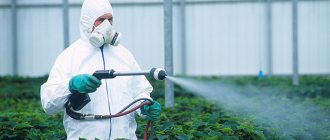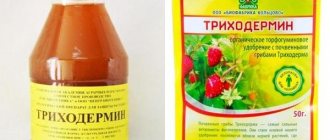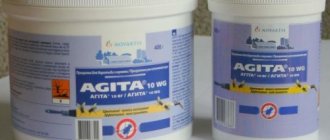When to use?
Bordeaux mixture in gardening helps to effectively fight most pathogenic lesions on the bark and leaves. In fruit and berry crops, after treatment, a larger number of fruits ripen, and deciduous and coniferous species significantly intensify their growth. In places where bark was removed and on cut branches treated with Bordeaux mixture, rot crusts and darkened areas of wood will not form.
The mixture should be used with caution, since copper compounds are toxic to humans. It is recommended to treat fruit and berry trees 2–4 weeks before harvest.
This improves the quality and stability of fruits during storage, while simultaneously reducing the residual concentration of copper on their surface. There are still disputes regarding the advisability of applying the composition to a summer cottage during the growing season, since the components of the drug can get on earlier fruit-bearing trees or shrubs.
Bordeaux mixture can lead to the appearance of a net structure in fruits and a change in their size. This effect is especially noticeable on cherries. A win-win option is to treat the trees before buds open. During this period, the mixture destroys most microorganisms at the initial stage. Liquids for early treatment of the garden should not be confused with those used during the growing season. A high concentration of active ingredients from the first 3% solution will negatively affect the development of a plant that has already lost its leaves. To treat green plants, use a 1% solution.
What is Bordeaux mixture
Formula of the substance: CuSO4 • 3Cu(OH)2 = copper sulfate + calcium hydroxide. If the composition is prepared correctly, it has high adhesion and remains on the crown and leaves of crops for a long time.
Bordeaux mixture is a combination of 3 substances:
- lime powder;
- copper sulfate;
- water.
After dilution, the solution acquires a soft blue tint. The main component of the mixture is copper. Its deficiency does not have the best effect on the formation and fruiting of plants. This applies to a greater extent to plantings on peat and acidic sandy soils.
For effective spraying, only a suspension with a neutral or slightly alkaline reaction is suitable. With a strong solution, there is a negative effect on the crown and leaves.
Copper in this preparation is an important trace element for the full formation of plants. If a crop grows on soils with its deficiency, then growth slows down, yield decreases, branches and leaves become deformed. Therefore, treatment with the blue mixture is an excellent way to combat diseases and additionally nourishes the plants.
Benefits of Bordeaux mixture
Many gardeners regularly use Bordeaux mixture due to its universal properties and significant benefits. Its chemicals instantly contact the plant. An undoubted advantage is that the mixture is not washed off by rain.
The protective characteristics of Bordeaux mixture last for about 30 days, which serves as an advantage over other similar compositions. It is required to use the drug in early spring or late autumn - this is a necessary condition for its effectiveness.
The liquid is highly effective against many pathogenic microorganisms and pathogens. Use is recommended for scab, rust, black rot, late blight, leaf curl, and melanosis.
Disadvantages of Bordeaux mixture
Bordeaux mixture belongs to the group of high-contact pesticides, so careful treatment is necessary to combat garden diseases. The drug cannot be combined with organophosphorus liquids, as well as mixtures that degrade in an alkaline environment.
Benefits of Bordeaux mixture.
If you use the drug for spraying annually, then there is a high accumulation of copper in the ground and the garden plants themselves, which provokes poor ovaries and the death of young seedlings at the beginning of the season.
The disadvantages of using the mixture include phytotoxicity for garden crops during their active growth, from April to August. An active oxidative reaction when sprayed with Bordeaux mixture during rain causes burns and cracks to appear on the crown of plants.
Due to the copper content, the mixture is unsafe for human health. Experts strongly recommend the use of respirators when diluting the product and processing the garden. This will help avoid poisoning from chemicals. For the same purposes, it is necessary to carry out work with liquid only in calm, sunny weather.
Composition and principle of action of the drug
The finished mixture is an aqueous solution of calcium hydroxide and calcium sulfate containing suspended copper hydroxide. The classic formulation of the drug includes three initial components - copper sulfate, quicklime and water. The concentration of the solution refers to the content of the initially taken copper sulfate based on the final aqueous mixture.
The mechanism of action of Bordeaux mixture is the influence of residual copper ions on pests and fungi, occurring at the cellular level. The mixture is effective not only when treating shrubs and trees, but also flowers with affected inflorescences. The composition has a repellent effect on many harmful insects, which are repelled by the presence of the drug from damaging the plant.
A solution of pure copper sulfate would be much more effective if it did not destroy the plant. Calcium compounds play the role of a binding component, neutralizing the negative effects of copper to an acceptable level.
Bordeaux mixture is harmful to humans. The main ways it enters the body:
- ingestion causes the most dangerous poisoning, which can occur after working with the drug or eating contaminated fruit. Treatment consists of gastric lavage, ingestion of protein and saline solutions, as well as cardiac medications;
- inhalation of aerosols causes a fever that lasts 2–3 days and is accompanied by bloating, tachycardia and nosebleeds.
If you suspect poisoning with copper compounds, you should call a doctor who will adjust the treatment and prescribe important stimulant medications.
Storage conditions
- Bordeaux mixture is stored until it reaches two years of age. It must be in its original sealed packaging;
- The packaging must contain a label, the name of the medicinal product and the date of manufacture;
- Storage temperature can be -30…+30˚C;
- Storing Bordeaux mixture in damaged packaging is prohibited;
- It is strictly forbidden to store the mixture near food.
Among the many comments from gardeners about the use of liquids, Bordeaux outweighs the positive reviews. With over 120 years of use as a fungicide, this tool has proven its effectiveness time and time again.
In this video you will learn how to properly prepare Bordeaux liquid to protect fruit trees:
Page 2
Flower lovers often use products such as epin for indoor plants, the use of which does not destroy some pests or eliminate diseases.
It plays an important role in increasing plant immunity. This makes the plants root faster, the seeds grow together, the ovaries grow larger, and the flowers become lush and colorful.
Let's consider the characteristics and instructions for using epina, its effectiveness for indoor flowers.
How to prepare the mixture at home without harm to health?
Preventing poisoning from the mixture is quite simple if you follow the general recommendations:
- When preparing and spraying the drug, use a respirator, gloves, headgear and protective outer clothing;
- do not smoke, drink or eat food between sprays;
- Do not spray the mixture in close proximity to fruits and vegetables that will be harvested for 2–3 weeks;
- Always rinse crops with water before use.
Keep in mind that during the spraying process, individual portions of the aerosol are carried tens of meters away. The result may be the penetration of substances onto trees and shrubs remote from the treatment site.
Features of application and results
The drug has proven itself not only for indoor plants, but also for gardeners and gardeners.
Do not harm the environment, insects, animals and people.
Epin is a truly unique assistant to the breeder, showing good results.
This can be seen in the example of the Great Botanical Garden. ANR They used gladiolas and tulips. The work was ahead of the development of those samples that were not processed. Experiments were also carried out with helium stocks.
As a result, it is a pleasure for gardeners and horticulturists who have received a rich harvest after cultivating the plantations and plantings and ripening the fruit two weeks earlier.
Preparing liquid at home
The scheme for mixing the components and obtaining the finished composition consists of several stages:
- the initial weighed portions of copper sulfate and quicklime are dissolved with stirring in a small amount of hot water. A separate container is taken for each solution. Lime slaking is not carried out in plastic buckets, since they can melt, and metal containers are not suitable for dissolving copper sulfate and storing Bordeaux mixture;
- both solutions are diluted with water to a volume of 5 liters, after which they are mixed;
- the copper sulfate solution is poured in a thin stream into the continuously stirred lime solution;
- the finished mixture is an opaque blue suspension. Its suitability for plant treatment should be checked by measuring the pH with litmus paper. If an acidic environment is detected, a small amount of lime solution must be added to the Bordeaux mixture. The readiness of the drug is indicated by a weak alkaline or neutral environment.
Colors of a litmus indicator: in a neutral environment it does not change color (yellow paper), in an acidic environment it acquires a crimson tint (some mistakenly consider it red), in an alkaline environment it shows a blue color.
Component ratios (for final volume 10 l):
- copper sulfate – 100 g (1% solution) or 300 g (3% solution);
- quicklime - 100 g (1% solution) or 300–500 g (3% solution).
After preparation, the drug should be used immediately (do not infuse) until the fine particles of copper hydroxide combine into larger conglomerates. Periodic stirring allows you to maintain a dispersed state of the solution. Long-term storage causes hydroxide particles to clump and precipitate, which will clog the sprayer nozzle. To preserve the mixture for use for a couple of days, add 5–10 g of sugar to it.
Watch the video for the process of preparing and using the liquid:
It will be cheaper to buy the ingredients for the Bordeaux mixture separately. A ready-made kit, including all components and litmus paper, is simpler, but more expensive.
Features of application, dosage and consumption
A suspension of the drug is applied to the surface of plants in early spring and summer by spraying. The prepared solution is poured into a tank, into which pressure is then injected (manually or from a carbon dioxide cylinder). Spray the mixture evenly on trees and shrubs, trying to get the liquid on all sides of the leaves and branches.
Features of using the product:
- the composition should be sprayed carefully, avoiding spills on yourself and on the ground;
- before work, you must make sure that there are no people without protective clothing (especially children) and animals in the spraying area;
- do not carry out work if there is a high probability of precipitation;
- Application should be made strictly in the direction of the wind.
The number of treatments is:
- before the appearance of buds – 1 (3% solution);
- during the growing season – 3–4 (1% solution);
- frequency of treatment (liquid validity period) – 10–14 days.
Mixture consumption:
- for trees (fruit and berry, deciduous and coniferous) and large shrubs – 15–20 liters per 100 m2;
- for medium-sized shrubs and grapes – 10–15 liters per 100 m2;
- for small bushes (strawberries, potatoes) – 5–10 liters per 100 m2.
Large trees that have external signs of fungal damage can be sprayed with a 1% solution of the mixture at the rate of 10–15 liters per tree.
The liquid remains an effective and cheap drug for the treatment and prevention of diseases of green spaces. Its widespread use in gardening is facilitated by the availability of components and ease of self-preparation. The versatility of the product allows for joint treatment of most plants and contributes to the overall health of the site.
Preparing a solution of Bordeaux mixture correctly
There are several features of the correct preparation of a solution of curb fluid that require a more detailed description.
Step-by-step recipe for a 1% solution:
- In an enamel, glass or plastic container, we dissolve 100 g of copper sulfate in 1 liter of hot water;
- We will pour four liters of cold water into this;
- In another container we add 1 liter of water to the powder. Do not use plastic containers to make lime mortar. High temperature can deform the lime during the cooling process;
- We also add four liters of cold water to this suspension;
- Both solutions are filtered through several layers of gauze;
- The copper sulfate solution is gradually introduced into the milk of lime by continuous stirring.
The 3% solution is made in the same way, only different amounts of components are removed. Now you need 300 g of copper sulfate, 450 g of quicklime and 10 liters of water.
What does Bordeaux mixture help with?
The substance is used to protect crops from various fungal and bacterial diseases. Most often, grapes, raspberries, strawberries, tomatoes, potatoes, and cucumbers are processed.
Bordeaux mixture protects plants from the following diseases:
- mildew;
- scab;
- rust;
- powdery mildew;
- fruit rot;
- macrosporiosis;
- peronosporosis;
- late blight;
- septoria;
- spotting;
- anthracnose
Bordeaux mixture protects plants from late blight
Treating the garden in the fall with Bordeaux mixture is an effective prevention of tree diseases. In this case, it is recommended to use a 3% solution. It is also necessary to take into account the time of harvest. Spraying must be done 2-3 weeks in advance. In order to protect green spaces from moniliosis, coccomycosis, scab and curl, treatment is carried out in the spring.
How to replace Bordeaux mixture? There are a large number of similar drugs. The most popular are “Polichom”, “Abigo-pik”, “Hom”, “Kuproksat” and “Oksikhom”.
Useful tips
Observe the concentration of the prepared liquid. An incorrectly prepared solution of Bordeaux mixture, for example, when using your own lime, the concentration may be impaired. By treating plants with this solution, you can burn the leaves. If the concentration is less, you will not get the expected result after treatment. This can be checked using the litmus test included in the package.
The reaction must be neutral or slightly alkaline. This will be indicated by the paper turning blue. If it turns red, add some milk of lime to the solution and test again.
You can check the correct concentration of the solution in a simple way. Dip any iron object (nail, wire, knife, etc.) into the liquid. If there is excess copper, then red spots will remain on the surface - traces of copper. If not, then the solution is normal and can be used.
- When mixing, the solutions must be cooled, so you get a good working solution.
- It is forbidden to add water to a ready-made working solution.
- Spraying is best done using a special sprayer.
- Before spraying, be sure to filter the working solution.
- When spraying, wear protective clothing, gloves, a respirator or mask. After carrying out work, remove protective clothing and be sure to wash your hands and face.
- Use the prepared solution on the day it is prepared. The next day, the beneficial properties of the insecticide are lost.
- The treatment is carried out in dry and cool weather, since high humidity can cause leaf burns.
- Before treating with Bordeaux mixture, it is advisable to thoroughly wet the entire plant so that the liquid flows into all the cracks in the bark. This is where the largest number of fungi and bacteria, as well as pests, accumulate.
Harm to humans
Bordeaux mixture is a toxic compound for the human body. Once in the digestive tract or respiratory organs, it causes severe intoxication, accompanied by irreversible inhibition of internal systems. Without timely medical care, a person dies.
You should absolutely not eat vegetables and fruits that have recently been treated with Bordeaux solution. Plant products are suitable for food only after at least 3 weeks after chemical exposure.
Before eating, vegetables and fruits must be thoroughly washed, or better yet, soaked in water for several hours.
Cooking method
Bordeaux mixture can be purchased in specialized stores in the form of a water-suspension concentrate (WSC). The volume of the plastic bottle varies from 100 ml to 500 ml. To prepare a working solution, simply mix the contents of the bottle with clean water in the proportion indicated on the package. To obtain 1% liquid, you need to dissolve 100 ml of concentrate in 10 liters of water. To prepare a 3% working solution, you need 250 ml for the same amount of clean water.
Most often, gardeners prepare Bordeaux mixture on their own at home, using 3 ingredients. Depending on the crop being treated, the growing season and the purpose of spraying, a 1% or 3% solution is used.
Instructions for use
A sprayer is required to evenly distribute the drug over the stems and leaves. The device is selected taking into account the height of the plants and the area to be treated:
- Beds and small plantations are sprayed with a hand sprayer.
- For large areas, use a 10-15 liter sprayer with a hand pump or pump.
- Trees and tall shrubs are treated with a garden-type device with a fishing rod. It is advisable to choose a longer fishing rod; it is more convenient to use. At its end there is a spray nozzle that ensures uniform coverage of the chemical on all parts of the plant.
The prepared working solution is poured into the sprayer tank. Spray the chemical evenly, being careful not to touch each area more than once.
For stone fruit trees
For one young seedling of cherries, apricots, plums, cherries, take 2 liters of Bordeaux solution. To treat an adult tree, 10 liters of the product should be prepared.
For grapes
In gardening and viticulture, Bordeaux mixture should be used correctly, taking into account the timing and application rates, so as not to worsen the yield. The vine is sprayed only in the spring, using 1.5 liters of the product per 10 m2 of plantation.
During the growing season, it is advisable not to touch the plants, but if necessary, it is better to use a Bordeaux solution substitute that does not contain copper. Vitriol negatively affects the formation of young shoots and worsens the quality characteristics of the berries.
For vegetable crops
To treat beds, it is better to buy a ready-made mixture in a bottle; it is easier to dilute for use in small areas. For 10 m2 of area take:
- for tomatoes 2 liters of solution;
- for cucumbers 2 l;
- for processing melon plantation 1 l;
- for potatoes 1 liter (regular processing is possible, but not more than 14 times during the growing season);
- for beets 1 l.


